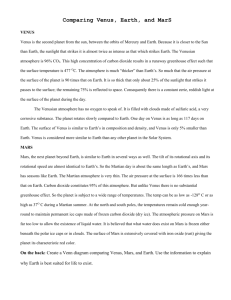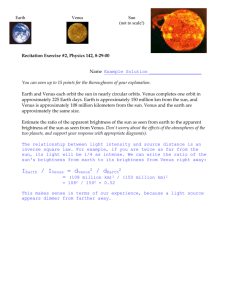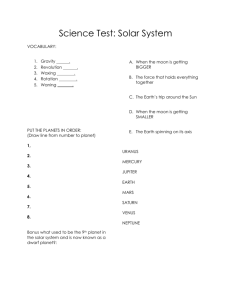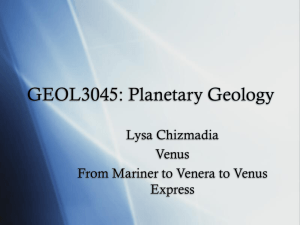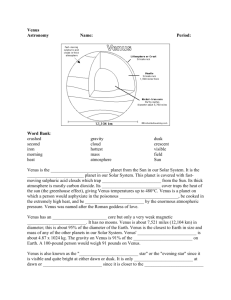Venus: Atmosphere & Surface
advertisement
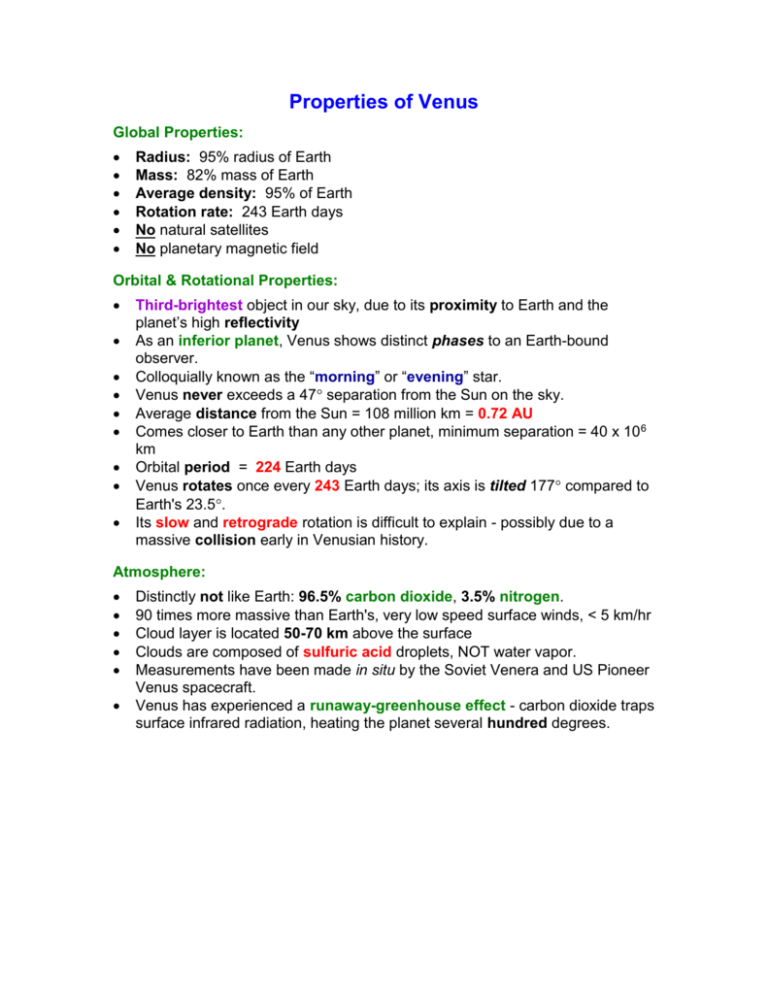
Properties of Venus Global Properties: Radius: 95% radius of Earth Mass: 82% mass of Earth Average density: 95% of Earth Rotation rate: 243 Earth days No natural satellites No planetary magnetic field Orbital & Rotational Properties: Third-brightest object in our sky, due to its proximity to Earth and the planet’s high reflectivity As an inferior planet, Venus shows distinct phases to an Earth-bound observer. Colloquially known as the “morning” or “evening” star. Venus never exceeds a 47 separation from the Sun on the sky. Average distance from the Sun = 108 million km = 0.72 AU Comes closer to Earth than any other planet, minimum separation = 40 x 10 6 km Orbital period = 224 Earth days Venus rotates once every 243 Earth days; its axis is tilted 177 compared to Earth's 23.5. Its slow and retrograde rotation is difficult to explain - possibly due to a massive collision early in Venusian history. Atmosphere: Distinctly not like Earth: 96.5% carbon dioxide, 3.5% nitrogen. 90 times more massive than Earth's, very low speed surface winds, < 5 km/hr Cloud layer is located 50-70 km above the surface Clouds are composed of sulfuric acid droplets, NOT water vapor. Measurements have been made in situ by the Soviet Venera and US Pioneer Venus spacecraft. Venus has experienced a runaway-greenhouse effect - carbon dioxide traps surface infrared radiation, heating the planet several hundred degrees. Surface Features and Geology: Mean surface temperature is about 730 K (!), due to carbon dioxide greenhouse effect. The surface is NOT visible from above the clouds. Topography investigated using radar and soft-landing spacecraft. The surface is rocky, no oceans, no bodies of water. Most of the surface is classified as rolling plains (65%), and lowlands (27%); “continents” comprise just 8%. No topographic evidence for plate tectonics. We see many structures which appear volcanic in origin, e.g., lava domes, shield volcanoes, lava flows, and the odd-shaped coronae The Soviet Venera landers photographed the surface around the spacecraft. They found that surface rocks were predominately basalt, produced by flowing lava. Analysis of the radar data suggests that the Venusian surface is probably less than 1 billion years old, and has been resurfaced by extensive volcanic activity. Erosion by wind and water does not occur. Interior: No observed magnetic field, a likely consequence of Venus' slow rotation. Little current data exists to constrain the interior. Probably a (partially ?) molten iron core exists, by analogy to Earth’s interior. Exploration: Much of our knowledge about Venus has been derived from spacecraft. Mariner 2 (1962 USA) – 1st flyby of another planet, confirmed surface temperature, did not detect a planetary magnetic field Venera 7 (1970 USSR) – 1st spacecraft to land on another planet Venera 9 (1975 USSR) – 1st photographs of surface Pioneer Venus (1978 USA) - radar-mapping orbiter, 5 atmospheric probes. Magellan (1989 USA) - high-resolution radar mapping mission; has provided the best images to date.





